An Improved Satellite ISAL Imaging Vibration Phase Compensation Algorithm Based on Prior Information and Adaptive Windowing
Abstract
1. Introduction
2. Methods
2.1. Imaging Geometry
2.2. Signal Model
2.3. Proposed Vibration Phase Error Compensation Algorithm
2.3.1. Phase Error Estimation Model
2.3.2. Vibration Phase Error Compensation Algorithm
2.3.3. Flowchart of the Proposed Algorithm
3. Results
3.1. Simulation Result
3.2. Real Data Experiment Results
4. Discussion
- Superior Image Quality: The algorithm achieves optimal performance in both visual assessments and objective metrics (e.g., image contrast improves 22% at −5 dB SNR compared to conventional methods), validating its effectiveness and robustness.
- Enhanced Iterative Efficiency: Statistical analysis reveals that the proposed algorithm requires estimation for only approximately 30% of range cells per iteration, dramatically decreasing computational load. By incorporating prior information and adaptive windowing, the proposed algorithm reduces the number of iterations by 16–50% compared to the PGMA and PGA methods, while yielding superior image quality, as evidenced by Figure 6.
5. Conclusions
Author Contributions
Funding
Data Availability Statement
Conflicts of Interest
References
- Crouch, S.; Barber, Z.W. Laboratory demonstrations of interferometric and spotlight synthetic aperture ladar techniques. Opt. Express 2012, 20, 24237–24246. [Google Scholar] [CrossRef]
- Wang, N.; Wang, R.; Mo, D.; Li, G.; Zhang, K.; Wu, Y. Inverse synthetic aperture LADAR demonstration: System structure, imaging processing, and experiment result. Appl. Opt. 2018, 57, 230–236. [Google Scholar] [CrossRef] [PubMed]
- Rasouli, S.; Rajabi, Y. Investigation of the inhomogeneity atmospheric turbulence at day and night times. Opt. Laser Technol. 2016, 77, 40–50. [Google Scholar] [CrossRef]
- Abdukirim, A.; Ren, Y.; Tao, Z.; Liu, S.; Li, Y.; Deng, H.; Rao, R. Effects of Atmospheric Coherent Time on Inverse Synthetic Aperture Ladar Imaging through Atmospheric Turbulence. Remote Sens. 2023, 15, 2883. [Google Scholar] [CrossRef]
- Liu, L. Coherent and incoherent synthetic-aperture imaging LADARs and laboratory-space experimental demonstrations. Appl. Opt. 2013, 52, 579–599. [Google Scholar] [CrossRef] [PubMed]
- Wang, X.; Li, C.; Jia, J.; Wu, J.; Shu, R.; Zhang, L.; Wang, J. Angular micro-vibration of the Micius satellite measured by an optical sensor and the method for its suppression. Appl. Opt. 2021, 60, 1881–1887. [Google Scholar] [CrossRef] [PubMed]
- Wang, X.; Guo, L.; Li, Y.; Han, L.; Xu, Q.; Jing, D.; Li, L.; Xing, M. Noise-robust vibration phase compensation for satellite ISAL imaging by frequency descent minimum entropy optimization. IEEE Trans. Geosci. Remote Sens. 2022, 60, 5704417. [Google Scholar] [CrossRef]
- Pellizzari, C.J.; Bos, J.; Spencer, M.F.; Williams, S.; Williams, S.E.; Calef, B.; Senft, D.C. Performance characterization of phase gradient autofocus for inverse synthetic aperture LADAR. In Proceedings of the 2014 IEEE Aerospace Conference, Big Sky, MT, USA, 1–8 March 2014; pp. 1–11. [Google Scholar]
- Martorella, M.; Haywood, B.; Berizzi, F.; Dalle Mese, E. Performance analysis of an ISAR contrast-based autofocusing algorithm using real data. In Proceedings of the International Conference on Radar, Adelaide, SA, Australia, 3–5 September 2003; pp. 30–35. [Google Scholar]
- Kragh, T.J.; Kharbouch, A.A. Monotonic iterative algorithm for minimum-entropy autofocus. In Proceedings of the Adaptive Sensor Array Processing Workshop, Lexington, MA, USA, 6–7 June 2006; pp. 1147–1159. [Google Scholar]
- Hu, X.; Li, D.J. Vibration phases estimation based on multi-channel interferometry for ISAL. Appl. Opt. 2018, 57, 6481–6490. [Google Scholar] [CrossRef] [PubMed]
- Yin, H.; Guo, L.; Li, Y.; Han, L.; Xing, M.; Zeng, X. Varying Amplitude Vibration Phase Suppression Algorithm in ISAL Imaging. Remote Sens. 2022, 14, 1122. [Google Scholar] [CrossRef]
- Song, Z.; Mo, D.; Wang, N.; Li, B.; Shao, Y.; Tan, R. Inverse synthetic aperture ladar autofocus imaging algorithm for microvibrating satellites based on two prominent points. Appl. Opt. 2019, 58, 6775–6783. [Google Scholar] [CrossRef]
- Song, Z.; Mo, D.; Li, R.; Wang, Y.; Shao, Y.; Tan, R. Phase gradient matrix autofocus for ISAL space-time-varied phase error correction. IEEE Photon. Technol. Lett. 2020, 32, 353–356. [Google Scholar] [CrossRef]
- Levtov, V.L.; Romanov, V.V.; Babkin, E.V.; Ivanov, A.I.; Stazhkov, V.M.; Sazonov, V.V. Measurement of vibration microaccelerations onboard the Mir orbital station using the VM-09 system of accelerometers. Cosmic Res. 2004, 42, 165–177. [Google Scholar] [CrossRef]
- Riaboukha, S.B.; Kiselev, S.V. Some Features of Vibrational Perturbations onboard the MirOrbital Station. Cosmic Res. 2001, 39, 120–125. [Google Scholar] [CrossRef]
- Wu, L.; Wei, X.; Yang, D.; Wang, H.; Li, X. ISAR Imaging of Targets With Complex Motion Based on Discrete Chirp Fourier Transform for Cubic Chirps. IEEE Trans. Geosci. Remote Sens. 2012, 50, 4201–4212. [Google Scholar] [CrossRef]
- Xi, L.; Guosui, L.; Ni, J. Autofocusing of ISAR images based on entropy minimization. IEEE Trans. Aerosp. Electron. Syst. 1999, 35, 1240–1252. [Google Scholar] [CrossRef]
- Wittig, M.E.; Holtz, L.V.; Tunbridge, D.E.L.; Vermeulen, H.C. In-orbit measurements of microaccelerations of ESA’s communication satellite OLYMPUS. In Proceedings of the Free-Space Laser Communication Technologies II, Los Angeles, CA, USA, 1 July 1990; pp. 205–214. [Google Scholar]
- Toyoshima, M.; Takayama, Y.; Kunimori, H.; Jono, T.; Yamakawa, S. In-orbit measurements of spacecraft microvibrations for satellite laser communication links. Opt. Eng. 2010, 49, 083604. [Google Scholar] [CrossRef]
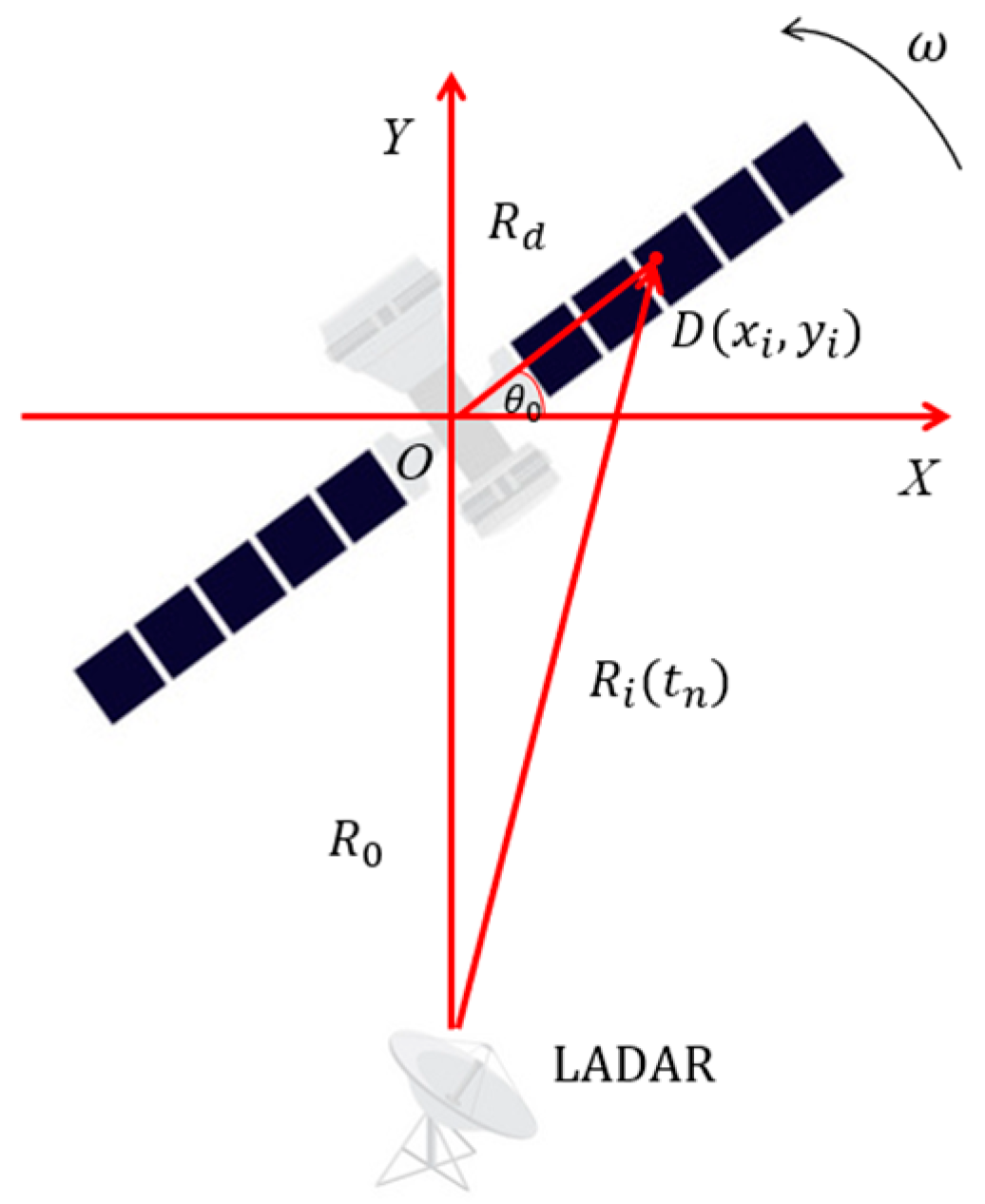
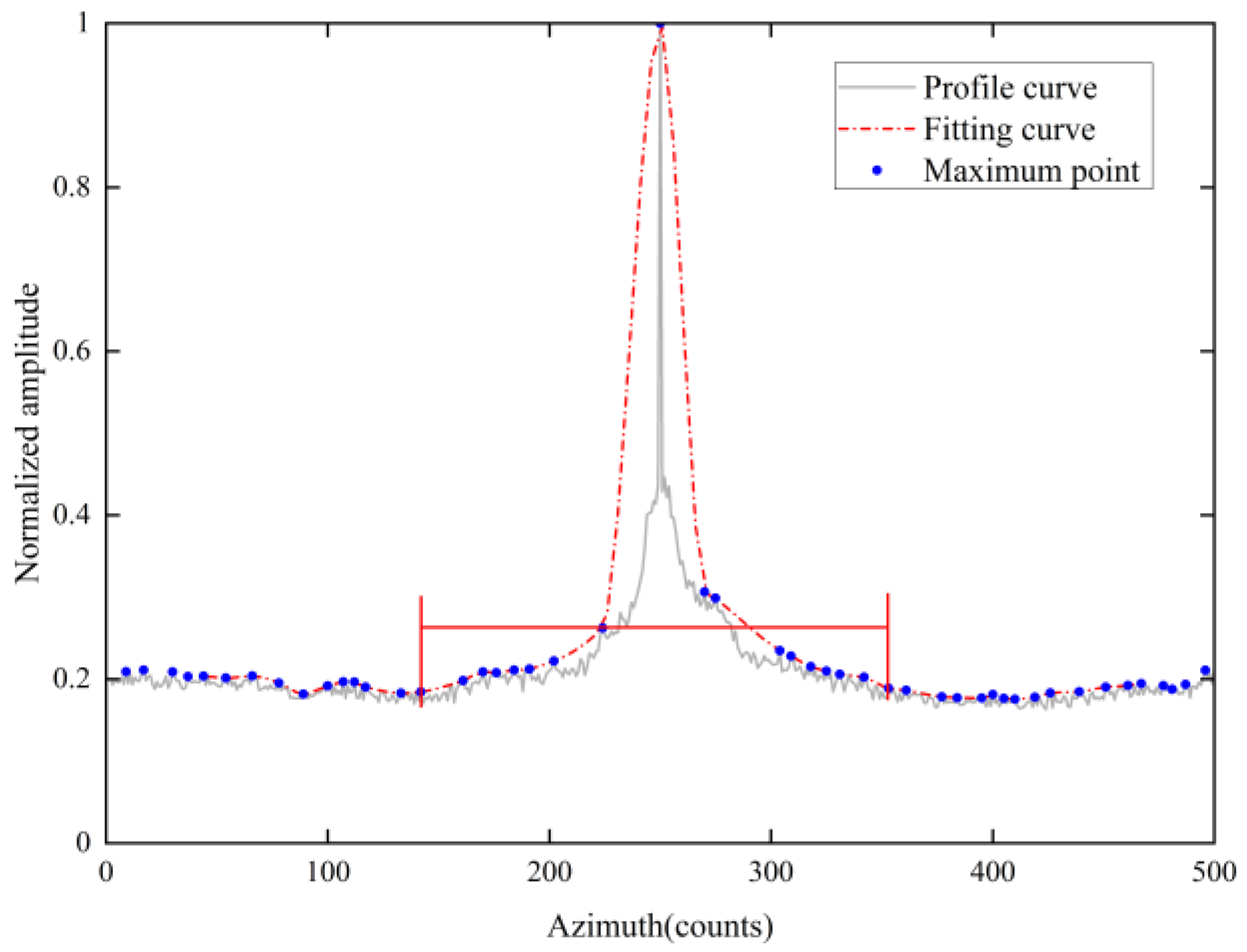
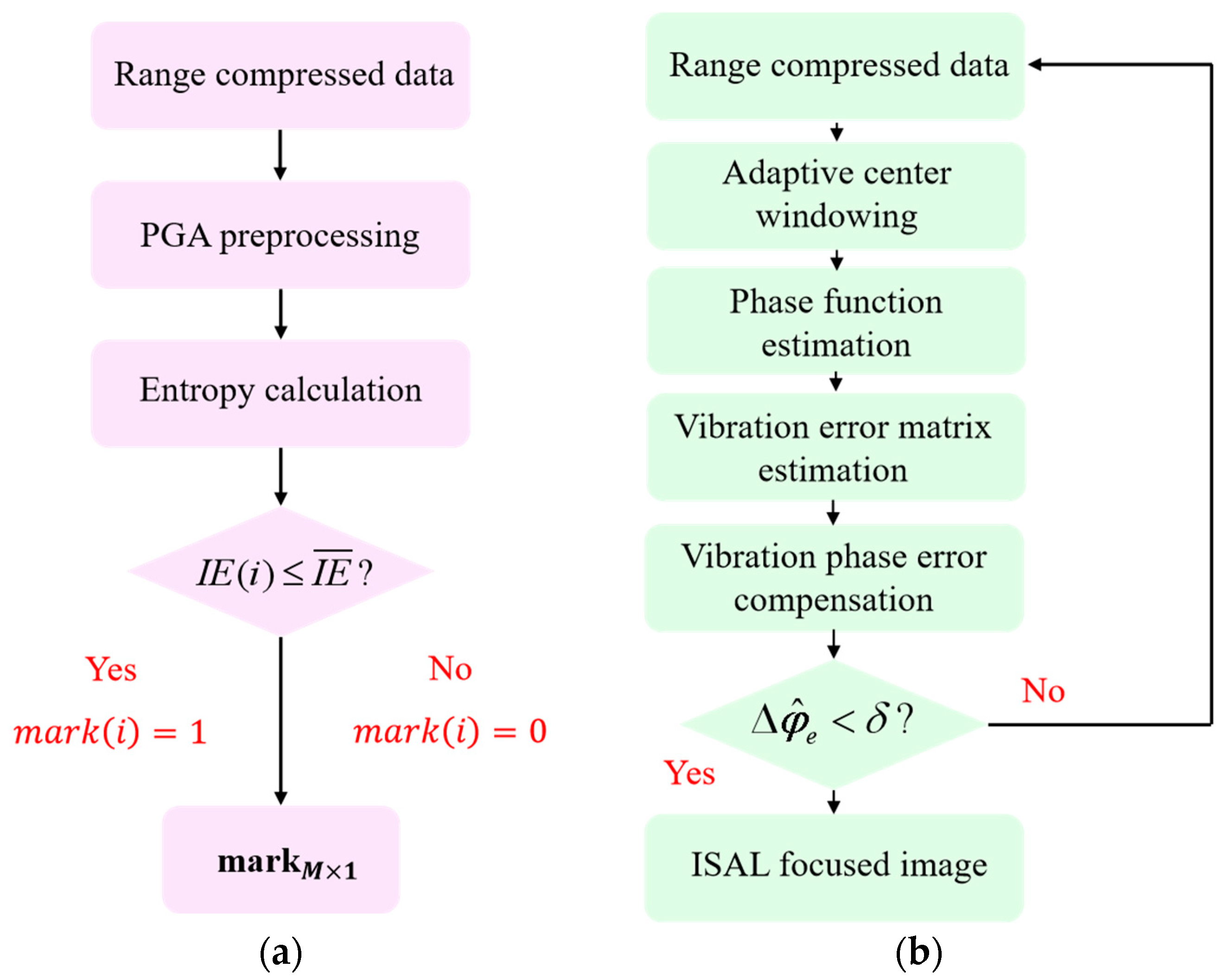
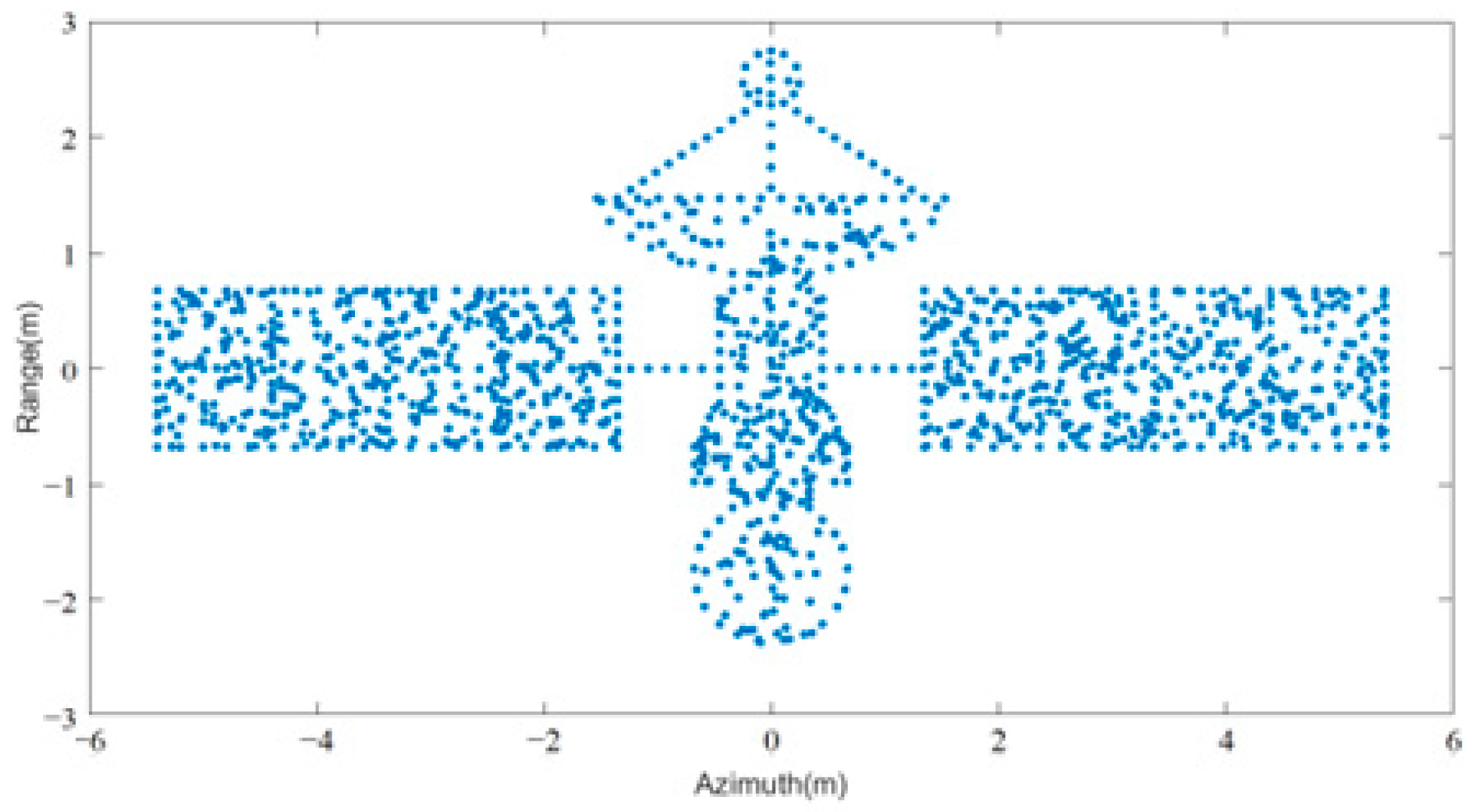
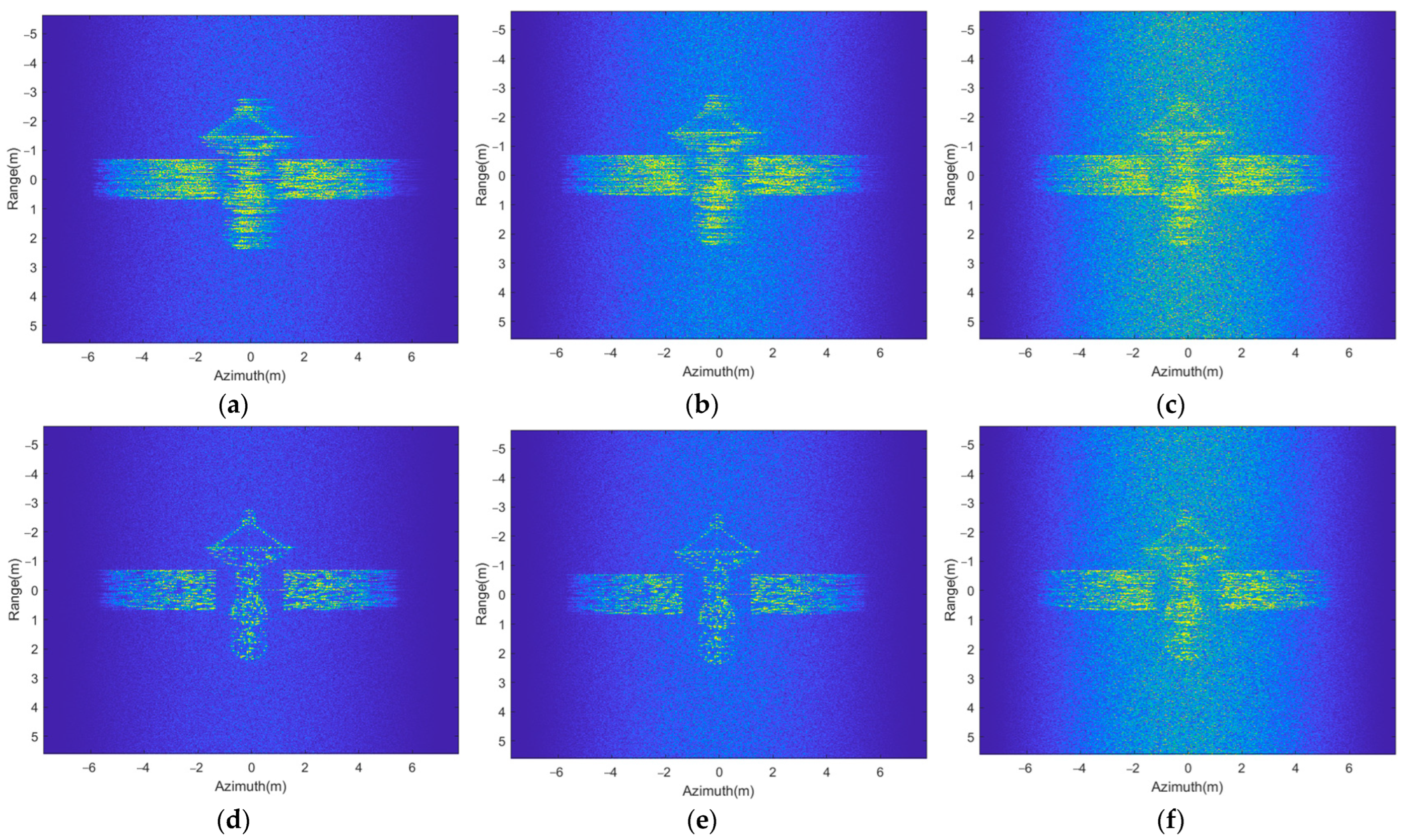



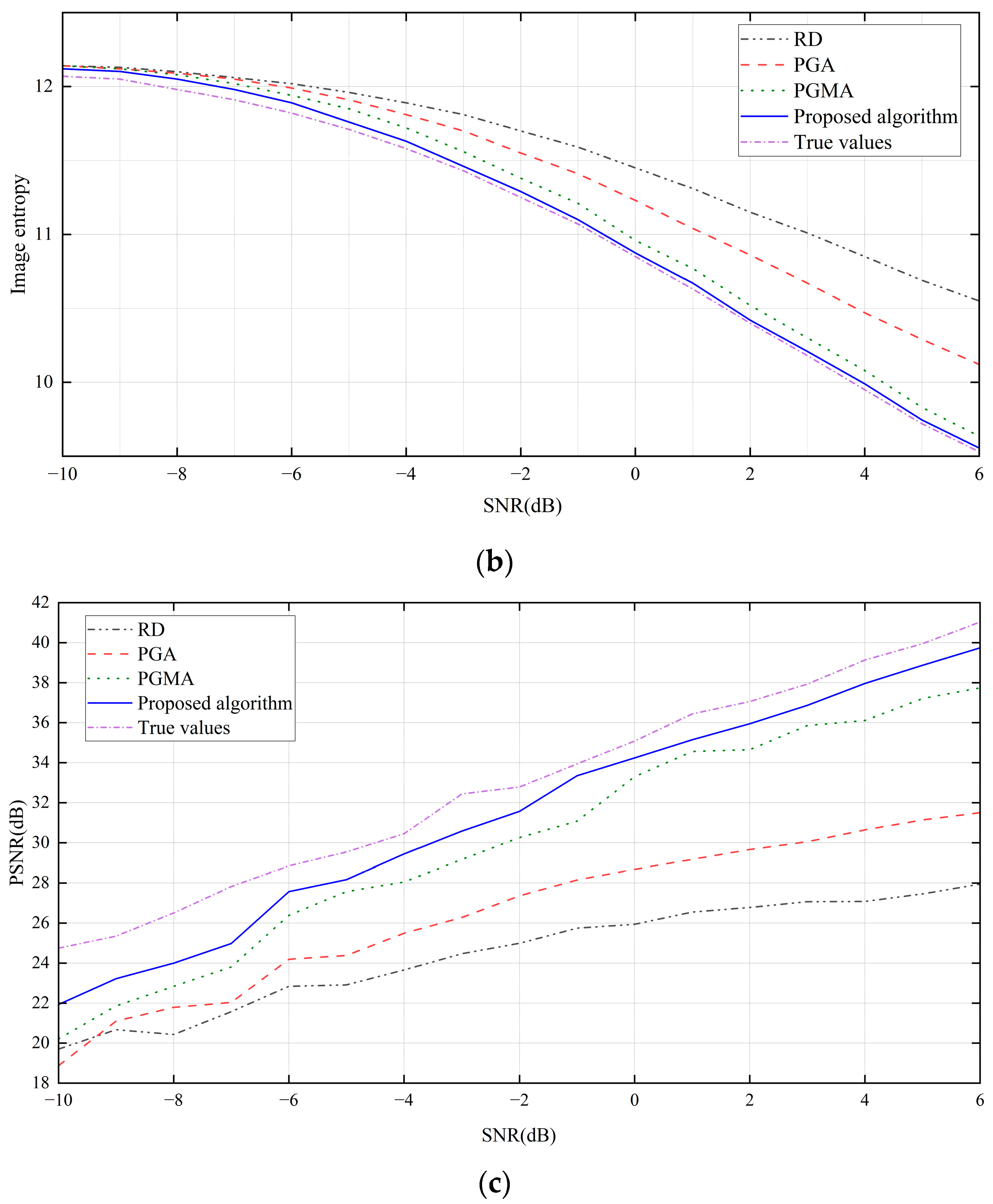


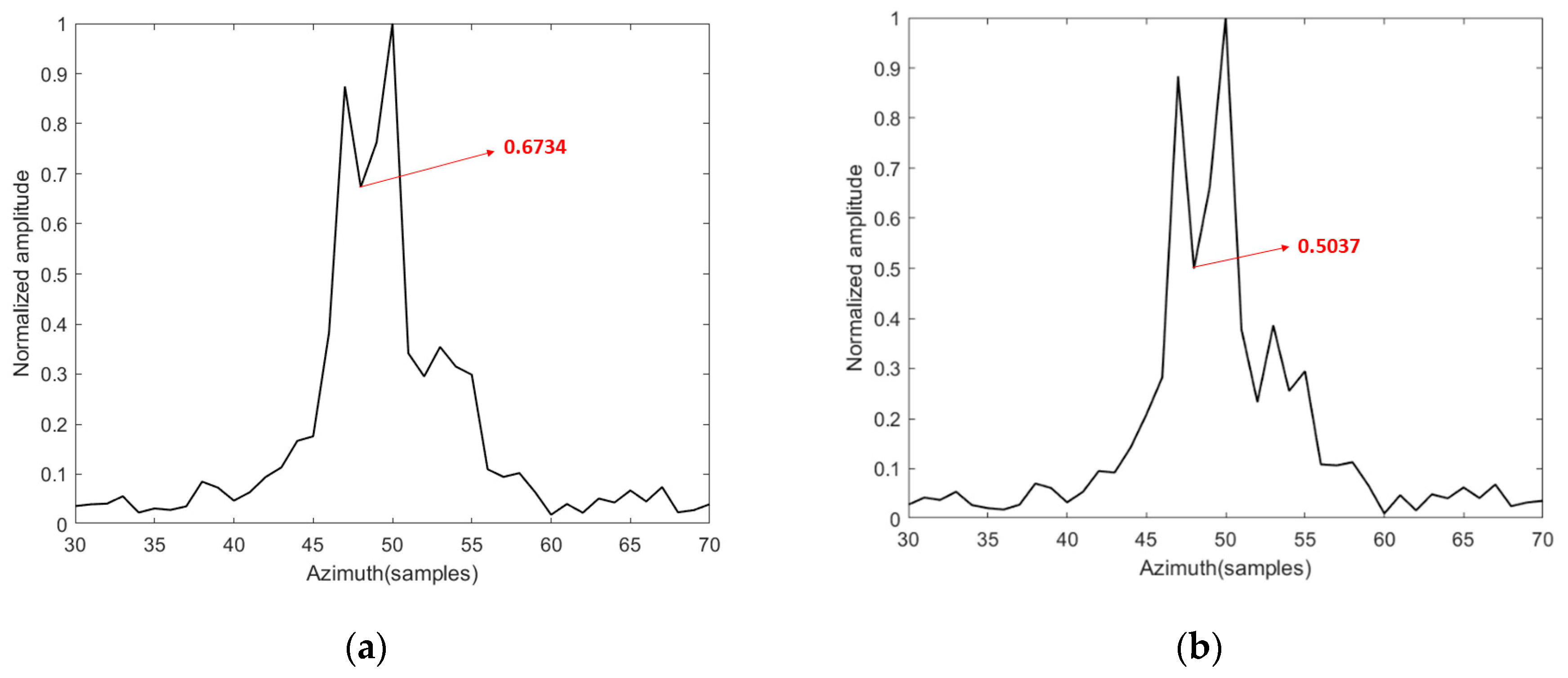

| Parameters | Values |
|---|---|
| Laser wavelength () | 1550 nm |
| Pulse repetition frequency (PRF) | 50 kHz |
| Bandwidth (B) | 8 GHz |
| Pulse width () | |
| Pulse number (N) | 500 |
| Angular rate of the target () | 2.5 mrad/s |
| Distance of the target (R0) | 50 km |
| IE | IC | PSNR | |||||||
|---|---|---|---|---|---|---|---|---|---|
| SNR/dB | −5 | 0 | 5 | −5 | 0 | 5 | −5 | 0 | 5 |
| True values | 11.71 | 10.85 | 9.72 | 3.12 | 6.11 | 9.22 | 29.54 | 35.08 | 39.95 |
| RD | 11.96 | 11.45 | 10.69 | 1.68 | 2.99 | 4.41 | 22.91 | 25.94 | 27.46 |
| PGA | 11.91 | 11.25 | 10.29 | 1.88 | 3.94 | 6.08 | 24.38 | 28.68 | 31.14 |
| PGMA | 11.85 | 11.29 | 9.84 | 2.35 | 5.56 | 8.80 | 27.57 | 33.30 | 37.45 |
| Proposed algorithm | 11.76 | 10.89 | 9.79 | 2.87 | 6.06 | 9.05 | 28.17 | 34.24 | 39.14 |
| IE | IC | |
|---|---|---|
| RD | 6.02 | 4.56 |
| PGA | 5.84 | 5.31 |
| PGMA | 5.72 | 6.18 |
| Proposed algorithm | 5.56 | 6.94 |
Disclaimer/Publisher’s Note: The statements, opinions and data contained in all publications are solely those of the individual author(s) and contributor(s) and not of MDPI and/or the editor(s). MDPI and/or the editor(s) disclaim responsibility for any injury to people or property resulting from any ideas, methods, instructions or products referred to in the content. |
© 2025 by the authors. Licensee MDPI, Basel, Switzerland. This article is an open access article distributed under the terms and conditions of the Creative Commons Attribution (CC BY) license (https://creativecommons.org/licenses/by/4.0/).
Share and Cite
Duan, C.; Liu, H.; Wu, X.; Tang, J.; Feng, Z.; Cao, C. An Improved Satellite ISAL Imaging Vibration Phase Compensation Algorithm Based on Prior Information and Adaptive Windowing. Remote Sens. 2025, 17, 780. https://doi.org/10.3390/rs17050780
Duan C, Liu H, Wu X, Tang J, Feng Z, Cao C. An Improved Satellite ISAL Imaging Vibration Phase Compensation Algorithm Based on Prior Information and Adaptive Windowing. Remote Sensing. 2025; 17(5):780. https://doi.org/10.3390/rs17050780
Chicago/Turabian StyleDuan, Chenxuan, Hongyuan Liu, Xiaona Wu, Jian Tang, Zhejun Feng, and Changqing Cao. 2025. "An Improved Satellite ISAL Imaging Vibration Phase Compensation Algorithm Based on Prior Information and Adaptive Windowing" Remote Sensing 17, no. 5: 780. https://doi.org/10.3390/rs17050780
APA StyleDuan, C., Liu, H., Wu, X., Tang, J., Feng, Z., & Cao, C. (2025). An Improved Satellite ISAL Imaging Vibration Phase Compensation Algorithm Based on Prior Information and Adaptive Windowing. Remote Sensing, 17(5), 780. https://doi.org/10.3390/rs17050780







